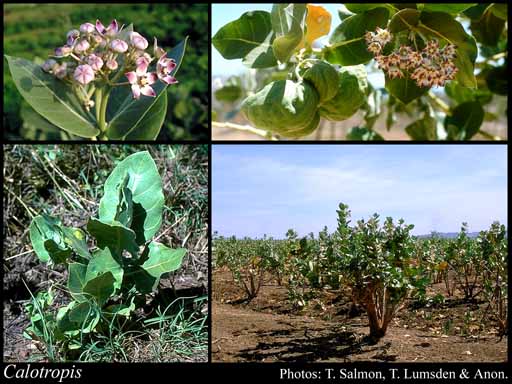- Reference
- Asclepiadeae 39 (1810)
- Name Status
- Current

Scientific Description
Common name. Rubber Bushes. Family Asclepiadaceae.
Sometimes included in Apocynaceae. Subfamily Asclepiadoideae, Tribe Asclepiadeae.
Habit and leaf form. Trees; laticiferous (with white latex). ‘Normal’ plants. Plants with roots (fibrous). Leaves cauline. To 4 m high (in Australia). Mesophytic. Leaves medium-sized; not fasciculate; opposite; decussate; not decurrent on the stems; somewhat fleshy; not imbricate; petiolate, or sessile. Petioles wingless. Leaves with ‘normal’ orientation; simple; epulvinate. Leaf blades dorsiventral; entire; flat; elliptic, or oblong; pinnately veined; cross-venulate; auriculate at the base, or cordate. Mature leaf blades adaxially glabrous (with thick, glaucous, waxy cover); abaxially glabrous (with thick, glaucous, waxy cover). Leaf blade margins entire; flat. Leaf anatomy. Hairs absent.
Reproductive type, pollination. Fertile flowers hermaphrodite. Unisexual flowers absent. Plants hermaphrodite. Plants homostylous.
Inflorescence and flower features. Flowers aggregated in ‘inflorescences’; racemiform in fascicles. Inflorescences simple; axillary; ascending. Flowers pedicellate; small; regular; 5 merous; cyclic; tetracyclic. Free hypanthium absent. Hypogynous disk absent. Perianth with distinct calyx and corolla; 10; 2 -whorled; isomerous. Calyx present; 5; 1 -whorled. Corolla present; 5; 1 -whorled; not appendiculate; gamopetalous; lobed; lobulate. Corolla lobes markedly longer than the tube. Corolla valvate; sub- rotate, or campanulate; regular; cream (tipped), or purple (tipped internally). Corolla lobes ovate. Corolla members entire. Androecium present. Androecial members definite in number. Androecium 5. Androecial members adnate (epipetalous); united with the gynoecium (as a gynostegium); all equal; coherent (connate); 1 -whorled. Stamens 5; all more or less similar in shape (not markedly capitate); isomerous with the perianth. Filaments appendiculate (in a staminal gynostegial corona composed of 5 lobes); connate into a tube, adnate to stigma. Anthers all alike; appendaged. The anther appendages apical. Pollen shed in aggregates; in tetrads. Gynoecium 2 carpelled. The pistil 2 celled. Carpels reduced in number relative to the perianth. Gynoecium syncarpous; synstylous; superior. Ovary plurilocular; 2 locular. Gynoecium stylate. Styles 2; partially joined (at the stylehead); apical. Stigmas 1; conical. Placentation axile. Ovules 30–50 per locule (‘many’).
Fruit and seed features. Fruit 70–120 mm long; dehiscent; 1 locular (in 2 follicles, with one often aborting). Dispersal unit the seed. Seeds endospermic; compressed (ovate); conspicuously hairy (comose at micropylar end); with a tuft of hairs. Cotyledons 2.
Geography, cytology, number of species. World distribution: occurring in northern Africa, Arabia and tropical Asia. Adventive. Australian states and territories: Western Australia, South Australia, Northern Territory, and Queensland. Northern Botanical Province. 2 species naturalised in Australia. A genus of 3 species; 2 species in Western Australia; C. procera (Aiton) W.T.Aiton, C. gigantea (L.) W.T.Aiton; 0 endemic to Western Australia.
Additional comments. From the Greek calo (beautiful) and tropis (keel), alluding to the prominent staminal coronal lobes.
Additional characters Calyx with colleters (secreting mucilage) (at sinus bases). Annular corona absent. Corolline corona absent. Gynostegial corona present; consisting of lobes (fleshy and laterally compressed); staminal. Gynostegial staminal corona without a conspicuous hump; without an adaxial appendage. Corpusculum oblong. Caudicles not winged; not geniculate. Pollinia in the anther locule pendulous; pellucid germinating mouth of pollinia absent. Pollen tetrads linear. Mature leaf blades bearing colleters (at lamina base).
Etymology. From the Greek for "beautiful" and "ship's keel"; refers to the keeled ‘corona leaflets’.